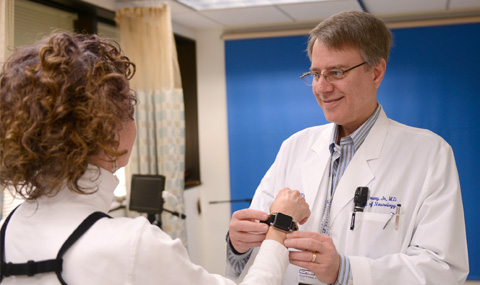
Richard Dewey, Jr, MD, demonstrates the APDM Mobility Lab, a portable set of sensors to help clinicians estimate the depth and severity of Parkinson’s disease. (Image source: University of Texas Southwestern Medical Center.)
Clinicians can be frustrated in accurately diagnosing Parkinson’s disease, since no blood tests or lab tests are currently available to identify the disease. A study at the University of Texas (UT) Southwestern Medical Center, however, recently found that the APDM Mobility Lab could effectively gauge the depth and severity of Parkinson’s disease among individuals affected by the disease.
Richard Dewey, Jr, MD, professor of neurology and neurotherapeutics, clinical director of the clinical center for movement disorders at UT Southwestern, was senior author of the study which appears in the Journal of the Nuerological Sciences.
Dewey says objective assessment tools are needed to hasten the development of therapeutic treatments for Parkinson’s disease. Reflecting on how the APDM Mobility Lab may help achieve that objective, Dewey says, “We might be able to actually measure the patient’s progress or regression thoroughly and objectively.”
Parkinson’s disease is typically diagnosed by using medical history, a neurological examination, and observation, according to the Parkinson’s Disease Foundation.
A media release from UT Southwestern Medical Center describes the APDM Mobility Lab as a device that uses wearable sensors and sophisticated signal processing to track even subtle changes in gait, stride, balance, rotation, and efficiency, and range of movement in upper and lower limbs and torsos.
The system reportedly is often used for athletic training purposes, as well as by universities to conduct research and evaluation.
According to the UT Southwestern media release, the study included a clinical trial that compared 135 individuals with Parkinson’s disease and 66 people without the disorder. The study subjects performed two tasks designed to assess gait and balance while connected to the APDM Mobility Lab through six small sensors on the limbs, chest, and lumbar area.
The trial was focused on diagnostics, rather than uncovering a new therapeutic approach to treatment, according to Thomas McConnell, MD, who reportedly was one of the trial’s study subjects. “But now we have hope for an earlier and more certain diagnosis of Parkinson’s disease, and identifying the most effective treatment,” McConnell says.

